T&BB report from Busworld Southeast Asia 2024
By Bradley Osborne - 18th June 2024
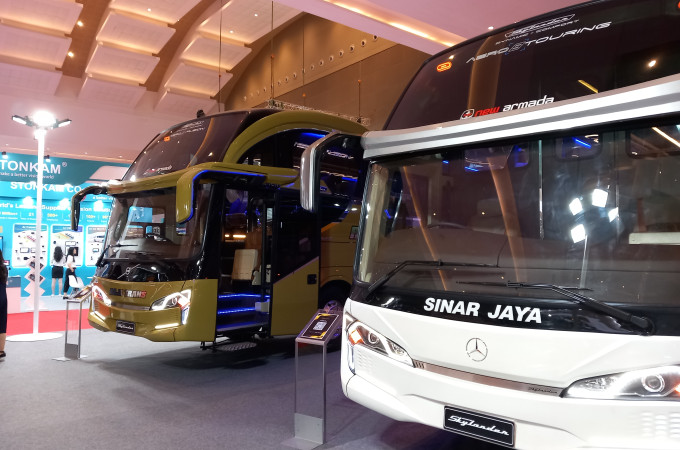
New Armada coaches at Busworld SEA 2024
Indonesia – After the 2022 edition of ‘Busworld Southeast Asia’, I argued that the divergent priorities of the Indonesian government and the country’s longstanding bus and coach manufacturers were on full display at the show. While the government talked about establishing a homegrown EV industry and replacing its bus fleets with electric vehicles in the over-polluted cities, the bus and coach bodybuilders proudly displayed their latest luxury models, designed to take tourists on diesel-fuelled excursions to the remoter parts of the archipelago. At this year’s show, held between 15-17 May at the Jakarta International Expo, the domestic manufacturers doubled the number of electric models on show – that is to say, they displayed a total of two electric buses instead of one. Though China’s Golden Dragon expanded its electric range on show from two to three, its compatriot, Zhongtong Bus, was not present this time. The impression I got two years ago of divergent, even opposing, ideas about the future of the market in Indonesia was confirmed by the latest show, which was much larger in scale and well attended following the final removal of all pandemic-era restrictions.
Although the number of Chinese OEMs fell from two to one, the country was well represented by its component suppliers. Of the larger firms, some worth mentioning include Songz, Stonkam, and Molead. Songz is already a major supplier to the Indonesian market, having already shipped 60,000 air-conditioning units for city bus fleets. Molead – a manufacturing concern which is closely tied to Yutong – also presented its bus air-conditioning systems, as part of an eclectic mix which included seats and electric chargers. Stonkam supplies safety equipment which uses cameras and artificial intelligence to detect pedestrians and other road users in the vicinity of the bus. A staggering 96% of the company’s sales are from exports to Europe, North America, Australia, and Japan, where vehicle safety standards are far advanced of those in Indonesia. Nevertheless, Stonkam told the press that it is looking for partners in the country to support the introduction of its products.
Road safety is purportedly one of the government’s key concerns, and it was a recurring theme in speeches and discussions at the show. The Indian subsidiary of French company Telma, manufacturer of induction brakes for commercial vehicles, displayed a retarder which fits on either the axle, the drive shaft, or the gearbox and dissipates excess braking energy. Telma locally produces around 20,000 units per year for the Indian market, and it is now looking to export some of this output to Indonesia. Telma established its Indian plant three years ago in response to new legal requirements for endurance braking systems, and it expects the same safety obligation will eventually be mandated in Indonesia as well.
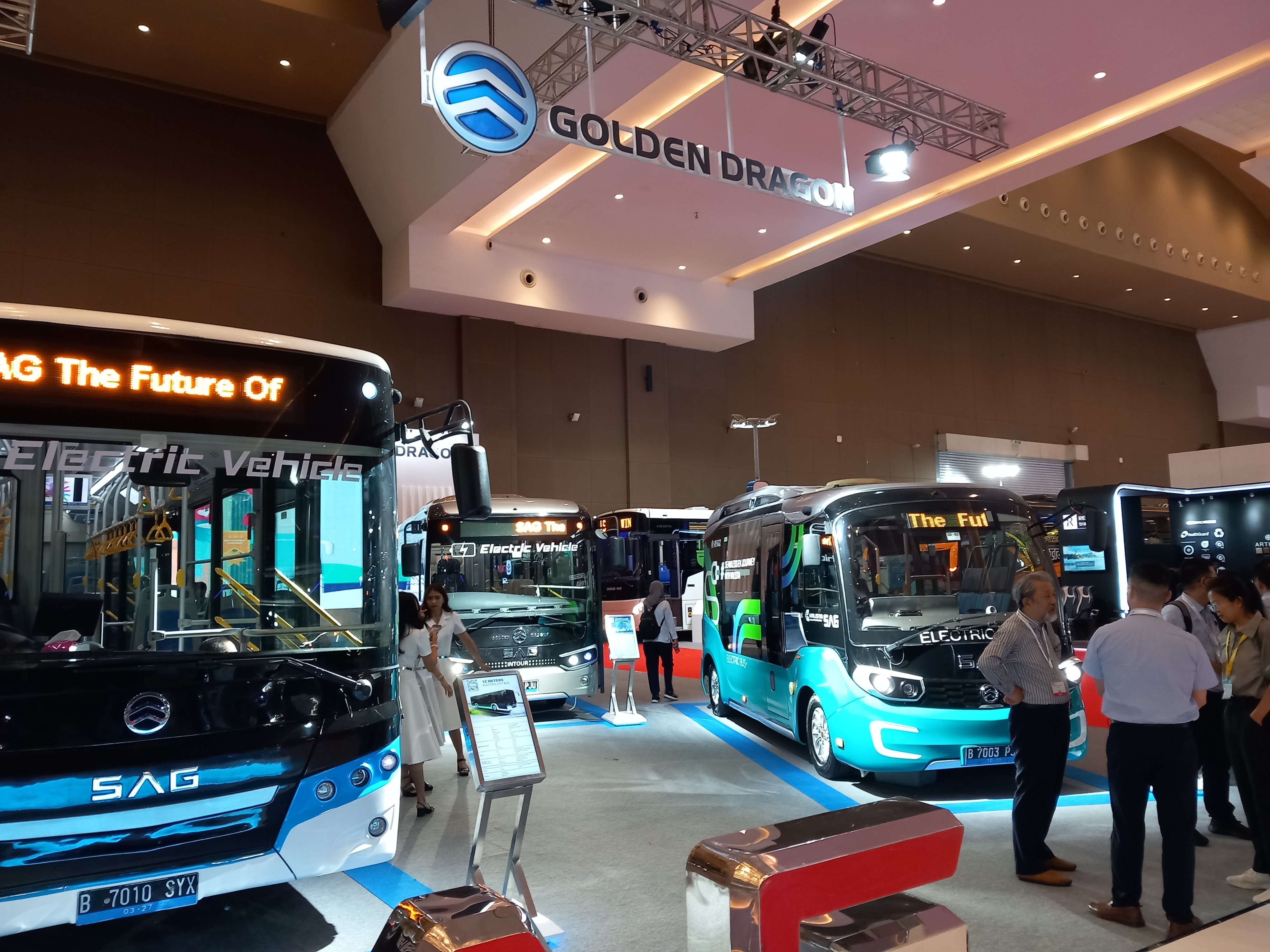
Golden Dragon stand
While Chinese suppliers dominated the show floor, Indian firms were in the majority during a series of company pitches delivered to potential buyers on the second day of the show. Two of these companies, Uno Minda and Pinnacle Industries, presented their product ranges for vehicle interiors. MassTrans and Ctrine Engineering offered digital services instead, explaining their fleet/depot management and product development software respectively. Finally, Meritor India, now a subsidiary of Cummins India, presented its range of drive axles and complete e-powertrain systems (the latter now sold under the ‘Accelera’ brand).
The prevailing opinion among Chinese and Indian suppliers is that Indonesia is a market which bears great potential for future growth. This conviction is reinforced by positive statistics from last year and projections for the development of the electric bus market (presented below). Nevertheless, glowing predictions about the progressive future of Indonesia’s bus and coach market rung false on the show floor, especially among its domestic manufacturers, whose outlooks and methods remain traditional. One executive registered his scepticism about electric vehicles during a discussion with members of the press. Moreover, the Indian firms who participated in the company pitches complained about high import duties and product standards which are unclear and inconsistently applied. In any case, one thing is apparent: while the door to the Indonesia market is not quite open yet, foreign suppliers will keep on pushing until it is.
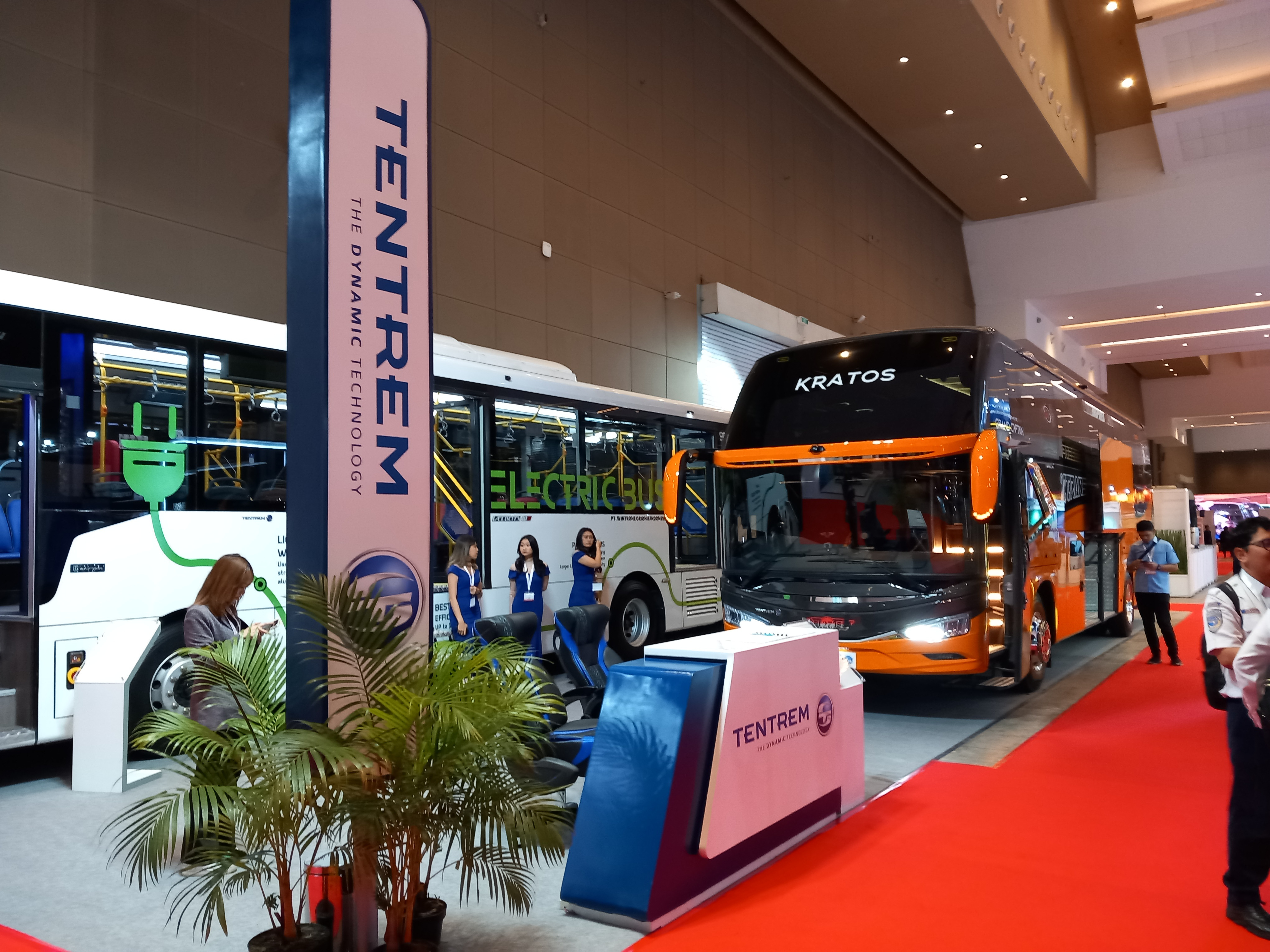
Tentrem stand
Overview of the bus and coach market in Indonesia
The following brief summary of the bus and coach market in Indonesia is based partly on figures published by T&BB (derived from industry association Gaikindo) and partly on a presentation given by a consultant from Frost & Sullivan during the show.
In 2023, Indonesia registered 6,233 new buses and coaches, a 52.5% increase on the year before, when 4,088 units were registered. Throughout the year, the Indonesian market performed remarkably well, growing by a whopping 135% in the first quarter and maintaining high rates in the second and third quarters of the year – and this in spite of the fact that Indonesia’s commercial vehicle market as a whole took a dip compared to 2022. The strong performance of the bus and coach market has largely been attributed to a post-pandemic recovery in travel and tourism; as such, Frost & Sullivan’s forecast for the market in 2028 undershoots the 2023 result, with 5,800 registrations projected (of which 75% will be transit buses).
Together with Thailand, Indonesia is predicted to become a pivotal production hub for overseas OEMs in the region. With its reserves of nickel and cobalt – some of the largest in the world – Indonesia carries significant potential to become a major manufacturer of EV components, particularly battery cells. To that end, the government has placed restrictions on exports of its raw materials, in order to prevent all of its precious nickel and cobalt from being shipped abroad to gigafactories in other countries. Its target for 2030 is to establish a production capacity of 140 GWh, based on an integrated supply chain where extraction and processing of the nickel and cobalt needed for certain lithium battery cells are carried out on domestic soil.
According to Frost & Sullivan’s analysis, Indonesia could achieve an electric bus penetration rate of 35% by the end of the decade. This would mean an approximate total of 5,600 battery electric buses on the road. And this is the more pessimistic scenario: Frost & Sullivan’s highest projection is a penetration rate of 60% or nearly 10,000 electric buses. With this many buses emitting zero emissions from their tailpipes, the country could reduce its carbon emissions per year by nearly 250,000 tonnes. The main obstacle which Indonesia must confront, according to Frost & Sullivan, is grid capacity. The country’s energy capacity will need to grow considerably to accommodate the demand coming from its electric buses; assuming a 60% penetration rate, these vehicles will require nearly 600 GWh of electricity per year. Moreover, Indonesia’s energy mix presents a challenge to its sustainability goals. Frost & Sullivan reports that, in 2022, 81% of Indonesia’s energy generation came from non-renewable sources, primarily coal and gas.
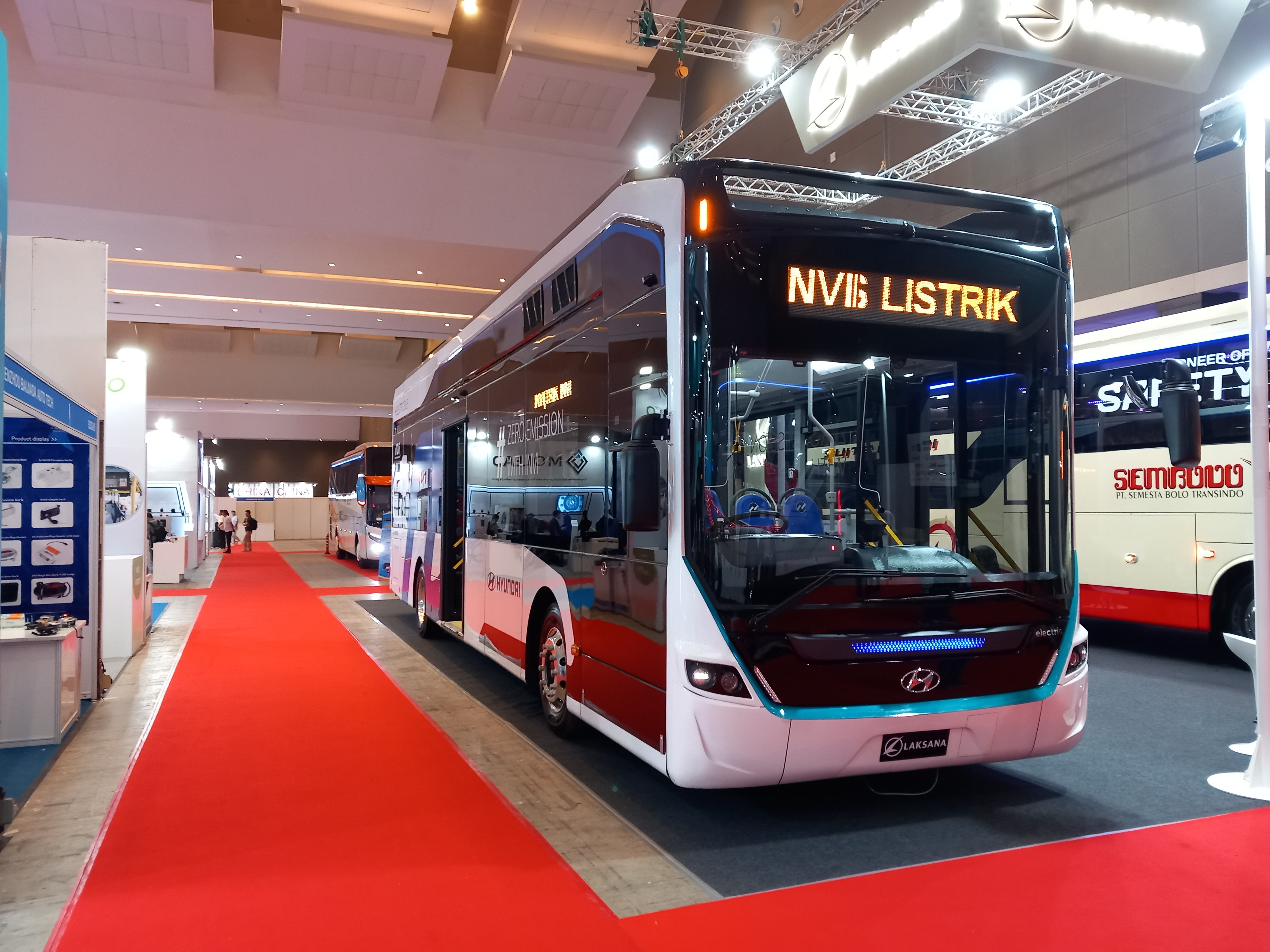
Laksana's Hyundai electric bus
Bus & coach manufacturers at the show
Indonesia’s mainstays in the bus and coach industry remain traditional manufacturers of vehicle bodies on chassis. Even their battery-powered buses are built on imported chassis, going against the trend towards integral design in the electric bus market. On the other hand, Golden Dragon, the sole Chinese vehicle manufacturer present at this year’s show, presented three battery electric buses which were designed and developed from the ground up, though they incorporate key components from suppliers (for example, batteries from CATL). The company has reportedly delivered twenty-two electric buses to Jakarta, and it clearly had the capital city in mind when deciding to display vehicles from the smaller end of its portfolio. Its 12-metre city bus, ‘In-Tour’ midibus and ‘All Star’ compact bus were all built to take up as little space as possible in the inner city.
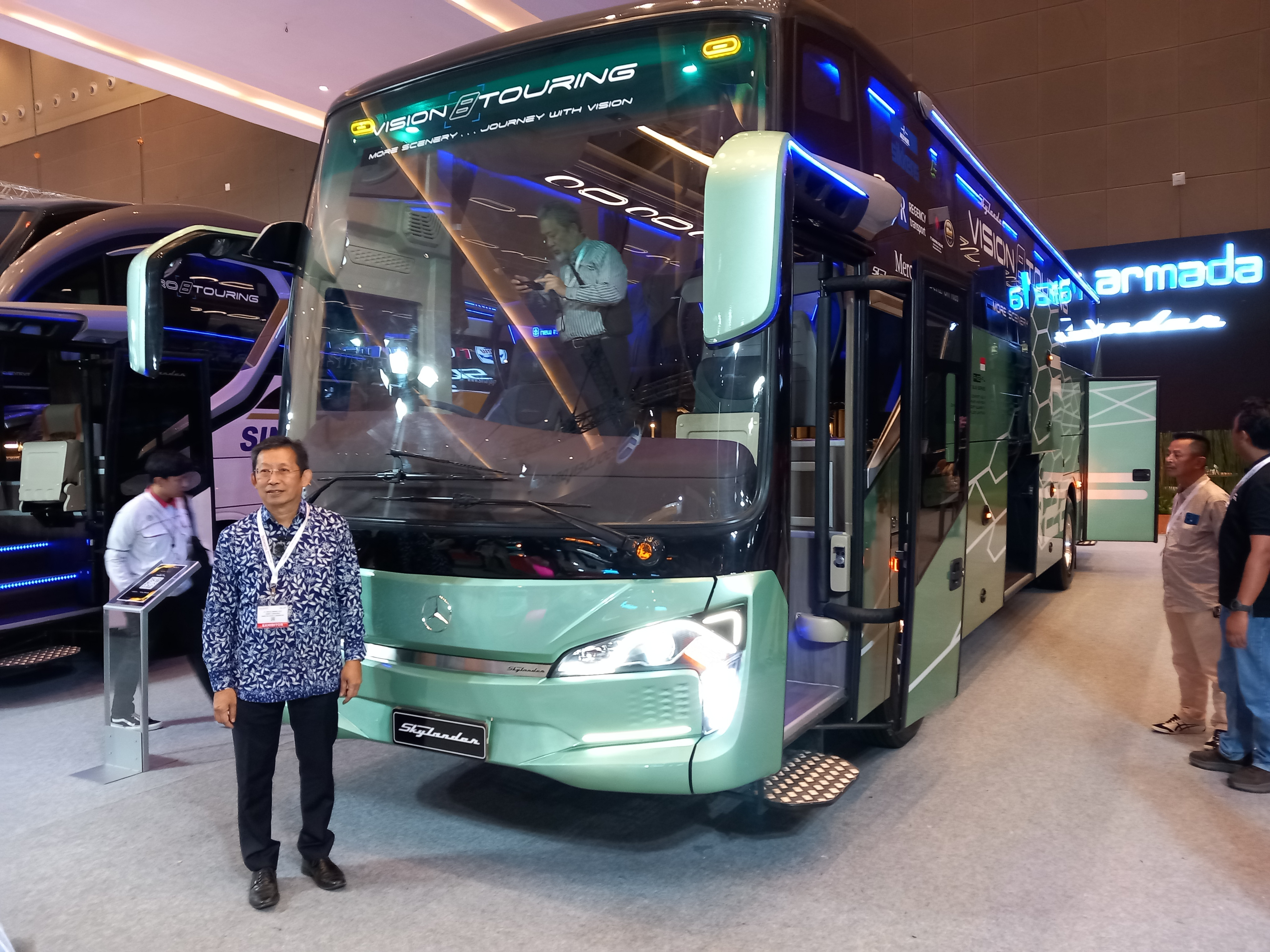
New Armada's latest Skylander coach
New Armada of Magelang celebrates its fiftieth anniversary this year, and fittingly it took the largest space in the hall with its six vehicles. On the smaller end were its minibus and city bus: an Isuzu Elf conversion and a ‘Citouro’ built on a Fuso chassis respectively. The other four vehicles were ‘Skylander’ coaches, three on Mercedes chassis and one on a Volvo. One of the Mercedes coaches was under wraps when the hall opened on the 15th; this was New Armada’s latest model, featuring a single pane for the windscreen instead of the double-glass front which is normally favoured by the coachbuilder. The press was informed that New Armada produced 2,500 vehicles altogether in 2023, of which 200 were coaches. These were sold to the domestic market only. Currently, New Armada is making EVs in very small volumes and selling them to the government. While the overall bus and coach market is growing after the pandemic lull, the demand for EVs from the private sector in Indonesia remains non-existent, according to New Armada.
Tentrem of Malang displayed two vehicles, a battery electric bus and an ‘Avante H8’ diesel-powered coach. The electric bus is based on a chassis which was produced by a new concern called ‘PT Wintrone Orionis Indonesia’, which T&BB understands to be an Indonesian-Taiwanese joint venture. It is the second EV to be made by Tentrem, following the ‘Velocity W5’ (with a chassis produced by state-owned rolling stock manufacturer INKA and batteries from a Jakarta-based firm) which was presented at the last show. The most unusual feature of Tentrem’s latest electric model is its high floor, which was chosen because of the vehicle’s intended application in a bus rapid transit (BRT) route with pedestrian stops placed high above the level of the road. The bus boasts a 300 to 400 kilometre range from a 400-kWh energy storage system and a stainless steel frame with aluminium body panels.
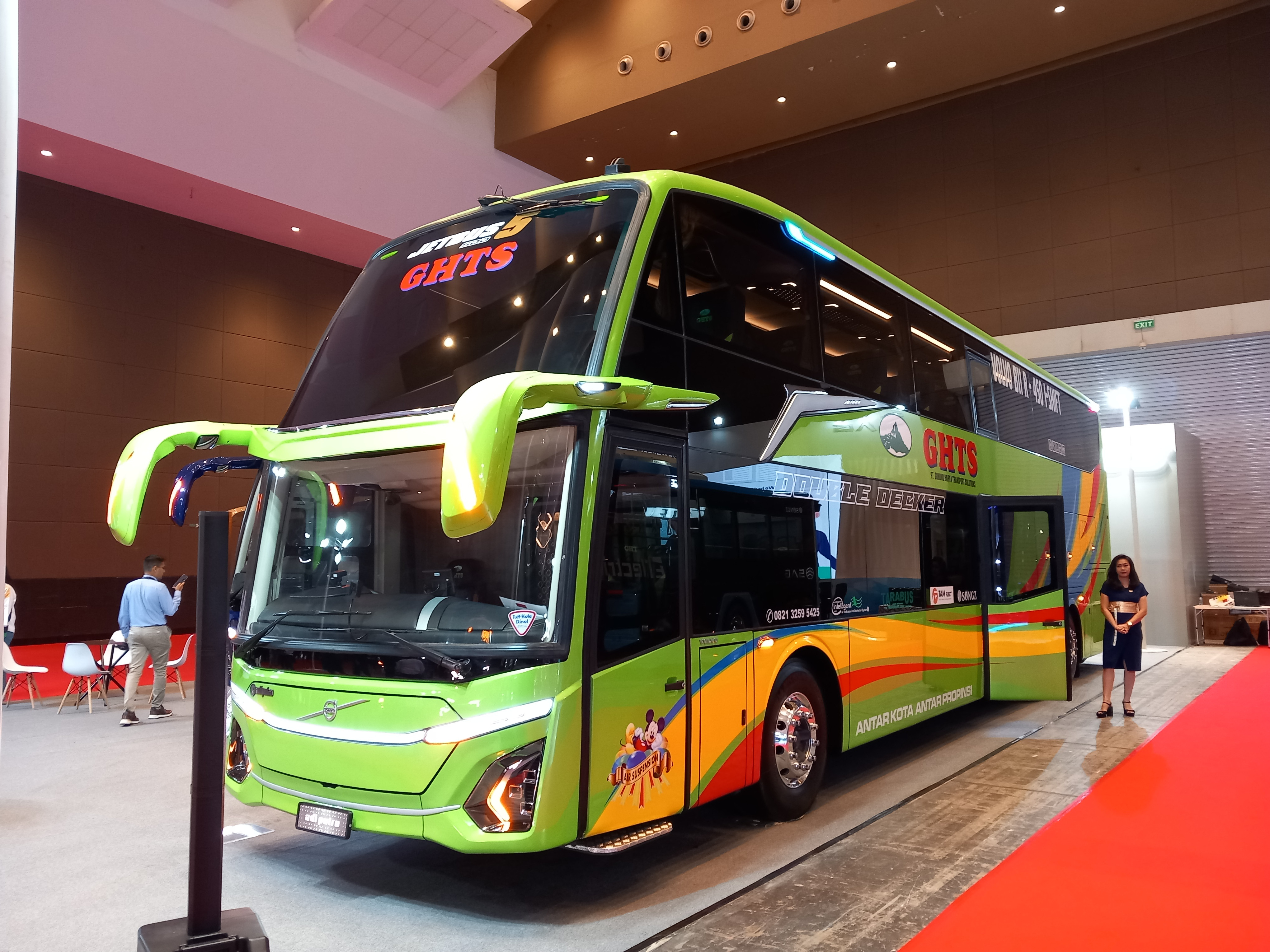
Adi Putro's Euro V coach
Laksana of Ungaran presented a battery electric bus and a Mercedes coach which featured an unusual design – a single deck seater layout in the front half of the vehicle and a double deck sleeper configuration in the rear. The electric bus was built on a Hyundai chassis and is based on Laksana’s ‘Nucleus’ range of city buses. Finally, Adi Putro of Malang displayed three of its ‘Jetbus’ coaches, two based on Mercedes chassis and one on a Volvo chassis. The three-axle Volvo was unusual in that it was powered by a Euro V engine, a premium option in a country where the emissions regulation is pegged at Euro IV. The Euro V engine was reportedly specified by a customer, though whether it was chosen purely for its lower carbon footprint is not clear. According to Adi Putro, demand for its coaches in the domestic market is growing in line with the expansion of the government’s roadbuilding programme.


